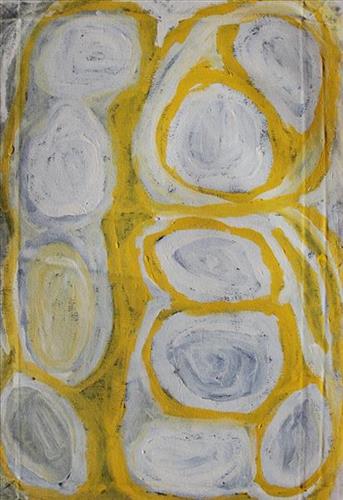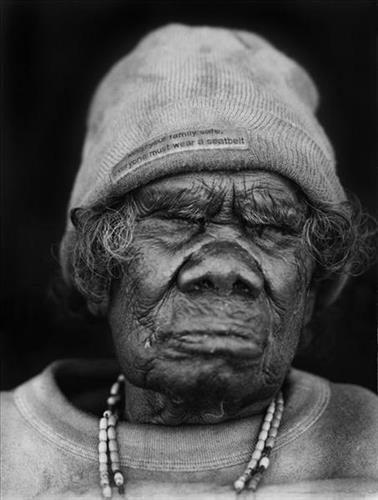111576341595
Untitled
“This is a rock hole that was made in the Jukurrpa (Dreamtime). These kanaputa (ancestral beings) are the stars in the sky, the Seven Sisters. They are standing up as a group of trees between Nyipily (Nyipil, Nibil, Canning Stock Route Well 34) and Kunawarritji. I was a little baby here at the rock holes of Kunawarritji and Nyarruri (Canning Stock Route Well 32). I painted all the little hills around that area. In the Jukurrpa, they were all squeezed out of the soft earth. People made them.”
– Nora Wompi (dec.)
Kunawarritji is an important site in the Great Sandy Desert where multiple stories and histories intersect. Originally a spring water and major Martu pujiman (traditional, desert dwelling) camping site, at the turn of the 20th century Kunawarritji was converted into a well along the Canning Stock Route. Each year throughout the 1930-50s, the well became a site of contact between the drovers, their cattle, and desert families like Wompi’s. Wompi was born near Lipuru (Libral Well, Canning Stock Route Well 37), north east of Kunawarritji. She grew up in the Country between these sites, and from an early age she and her family had encounters with drovers along the Canning Stock Route. As a young woman, Wompi followed the drovers north to Balgo Mission, where she stayed for many years. She learned to paint there with her close friend, Artist Eubena Nampitjin, and returned to Kunawarritji when it became a community in its own right.
As Wompi describes in her account, Kunawarritji features as an important site in the Minyipuru (Jakulyukulyu, Seven Sisters) Jukurrpa (Dreaming). Minyipuru is a central Jukurrpa narrative for Martu, Ngaanyatjarra, Pitjantjatjara and Yankunytjatjara people that is associated with the seasonal Pleiades star constellation. Beginning in Roebourne on the west coast of Western Australia, the story morphs in its movement eastward across the land, following a group of women as they walk, dance, and even fly from waterhole to waterhole. As they travelled the women left markers in the landscape and create landforms that remain to this day. During the entirety of their journey the women are pursued by a lustful old man, Yurla, although interactions with other animals, groups of men, and spirit beings are also chronicled in the narrative. The Minyipuru travelled to Kunawarritji from Nyipily (Nyipil, Nibil, Canning Stock Route Well 34), and transformed themselves into a distinctive group of trees that remain in the area between these two sites. From Kunawarritji Yurla followed the sisters to Pangkapirni, where he finally caught one of the women.
The Wati Kujarra (Two Goanna Men) is another important Jukurrpa narrative that passes through Kunawarritji. This story also features frequently in Wompi’s paintings for this area. The Wati Kujarra existed as half men, half goanna. They were responsible for the creation of many land features in Martu Country and beyond as they travelled, hunted and burned Country together.
Today, Kunawarritji is a site of return, a place where people came back to continue their life in the desert with the formation of Kunawarritji Aboriginal community in the early 1980s. The community’s cultural significance endures, with the population swelling up to 1000 during cultural business. In her late years Wompi relocated to her homelands at Kunawarritji, though she continued to travel regularly between Kunawarritji and Balgo. Wompi was a custodian of a great deal of cultural knowledge about the Kunawarritji area, much of which is referred to in her extensive body of work.




